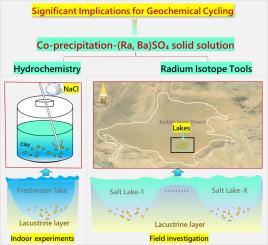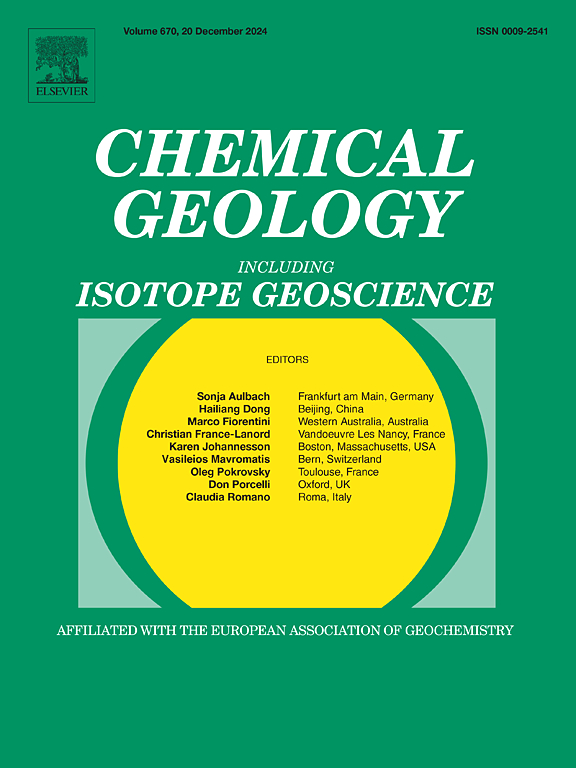Co-precipitation of radium in high–salinity environments: Implications from laboratory experiments and field surveys
IF 3.6
2区 地球科学
Q1 GEOCHEMISTRY & GEOPHYSICS
引用次数: 0
Abstract
The co-precipitation of radium (Ra) with minerals is prevalent in high-salinity environmental systems, with significant implications for geochemical cycling and radiation risk management. This study extensively investigated Ra co-precipitation through both indoor lake experiments and field investigations of saline lakes. 1) In the indoor experiments, calcium ions (Ca2+) concentration remained stable under high-salinity conditions, while barium ions (Ba2+) showed a marked and continuous decline. Ra is less likely to co-precipitate with Ca minerals but has a higher tendency to co-precipitate with Ba sulfates. However, field investigations provided limited support for co-precipitation based on water chemistry. Variations in Ca2+ and Ba2+ with total dissolved solids (TDS) in saline lakes showed no significant correlation, and both calcite and Ba sulfates may precipitate from solution. Thus, water chemistry profiles can provide an initial assessment of potential co-precipitation occurrences. 2) Our study revealed the responses of four Ra species in high-salinity solutions. Within the selected salinity range, the activity of long-lived Ra significantly decreased, and the calculated precipitation rates indicated their co-precipitation with minerals. Although the co-precipitation signals of short-lived Ra may be obscured by desorption and rapid decay, reasonable calculations confirm that they also underwent co-precipitation. The co-precipitation of all Ra species may be attributed to the compression of the anti-ionic diffusion layer around particles under high-salinity conditions. The molar ratio of Ra to Ba in Ba sulfates is significantly higher than that in gypsum and calcite (Ra/Ca), indicating the probably dominant role of Ba sulfates in co-precipitation. Additionally, variations in Ra/Ba ratios and concentrations of Ba and SO₄2− across these systems further elucidate the control exerted by Ba sulfates on Ra co-precipitation. 3) Previous studies have focused primarily on Ra co-precipitation mechanisms in groundwater and controlled experimental systems, while research on other high-salinity environments, such as saline lakes, remains limited. Findings from our saline lake systems further confirm the prevalence of Ra co-precipitation and provide important insights for other high-salinity natural systems (e.g., the Dead Sea) and polluted environments (e.g., mining sites) where Ra co-precipitation constraints may differ from those in saline lakes. In saline lake systems, salinity/TDS regulate mineral saturation indices (SI) by modulating Ra desorption and SO₄2− levels, thereby controlling (Ra, Ba)SO₄ formation, while the effects of pH and temperature are relatively minor. A limitation of this study is the lack of investigation into the influence of fine colloids and potential complexes on Ra species, a discussion that could offer preliminary insights into Ra transport and applications in other high-salinity systems.

高盐度环境中镭的共沉淀:实验室实验和实地调查的启示
镭(Ra)与矿物共沉淀现象在高盐度环境系统中十分普遍,对地球化学循环和辐射风险管理具有重要影响。本研究通过室内湖泊实验和盐湖实地调查对镭的共沉淀进行了广泛研究。1) 在室内实验中,钙离子(Ca2+)浓度在高盐度条件下保持稳定,而钡离子(Ba2+)则出现了明显的持续下降。Ra 与 Ca 矿物共沉淀的可能性较小,但与 Ba 硫酸盐共沉淀的可能性较大。然而,实地调查为基于水化学的共沉淀提供了有限的支持。盐湖中 Ca2+ 和 Ba2+ 随溶解固体总量(TDS)的变化没有显示出明显的相关性,方解石和硫酸钡都可能从溶液中析出。因此,水化学剖面可以对潜在的共沉淀现象进行初步评估。2) 我们的研究揭示了四种镭在高盐度溶液中的反应。在选定的盐度范围内,长寿命镭的活性显著降低,计算得出的沉淀率表明它们与矿物发生了共沉淀。虽然短寿命镭的共沉淀信号可能会被解吸和快速衰变所掩盖,但合理的计算证实它们也发生了共沉淀。所有镭元素的共沉淀都可能是由于在高盐度条件下颗粒周围的反离子扩散层受到了压缩。钡硫酸盐中 Ra 与 Ba 的摩尔比(Ra/Ca)明显高于石膏和方解石,这表明钡硫酸盐在共沉淀中可能起主导作用。此外,这些系统中 Ra/Ba 比率以及 Ba 和 SO₄2- 浓度的变化进一步阐明了 Ba 硫酸盐对 Ra 共沉淀的控制作用。3) 以前的研究主要集中在地下水和受控实验系统中的镭共沉淀机制,而对其他高盐度环境(如盐湖)的研究仍然有限。盐湖系统的研究结果进一步证实了镭共沉淀的普遍性,并为其他高盐度自然系统(如死海)和污染环境(如采矿场)提供了重要启示,在这些环境中,镭共沉淀的限制因素可能与盐湖中的不同。在盐湖系统中,盐度/TDS 通过调节 Ra 解吸和 SO₄2- 的水平来调节矿物饱和度指数 (SI),从而控制 (Ra, Ba)SO₄ 的形成,而 pH 和温度的影响相对较小。这项研究的一个局限性是缺乏对细小胶体和潜在复合物对 Ra 物种影响的调查,而这一讨论可为 Ra 在其他高盐度系统中的迁移和应用提供初步见解。
本文章由计算机程序翻译,如有差异,请以英文原文为准。
求助全文
约1分钟内获得全文
求助全文
来源期刊

Chemical Geology
地学-地球化学与地球物理
CiteScore
7.20
自引率
10.30%
发文量
374
审稿时长
3.6 months
期刊介绍:
Chemical Geology is an international journal that publishes original research papers on isotopic and elemental geochemistry, geochronology and cosmochemistry.
The Journal focuses on chemical processes in igneous, metamorphic, and sedimentary petrology, low- and high-temperature aqueous solutions, biogeochemistry, the environment and cosmochemistry.
Papers that are field, experimentally, or computationally based are appropriate if they are of broad international interest. The Journal generally does not publish papers that are primarily of regional or local interest, or which are primarily focused on remediation and applied geochemistry.
The Journal also welcomes innovative papers dealing with significant analytical advances that are of wide interest in the community and extend significantly beyond the scope of what would be included in the methods section of a standard research paper.
 求助内容:
求助内容: 应助结果提醒方式:
应助结果提醒方式:


